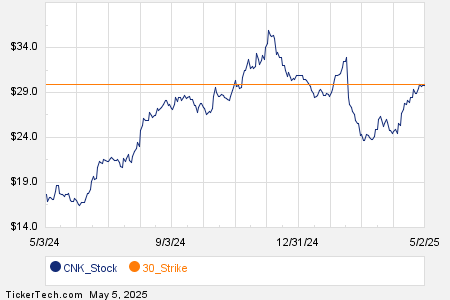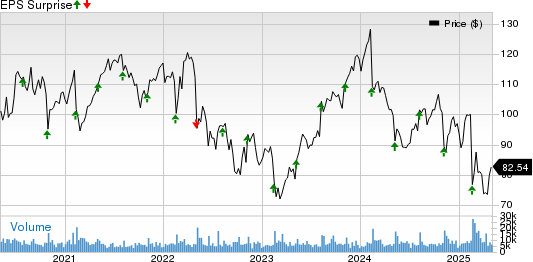“`html
Microsoft Rebounds with Strong Q3 Performance and AI Investments
Like many megacap growth stocks, Microsoft (NASDAQ: MSFT) faced a significant decline year-to-date due to a widespread sell-off, tariff concerns, and recession fears. Recently, however, Microsoft and similar growth stocks have seen a resurgence.
On Thursday, Microsoft’s stock surged following a robust third-quarter fiscal 2025 report that included strong guidance. At the time of this writing, Microsoft has made such a substantial recovery that it is now in positive territory for the year, even though major indexes like the S&P 500 (SNPINDEX: ^GSPC) and Nasdaq Composite (NASDAQINDEX: ^IXIC) remain negative.
Impressive Growth Metrics
Microsoft exceeded quarterly expectations, showcasing a 16% increase in overall revenue, a 14% rise in operating income, and a 10% gain in diluted earnings per share.
Microsoft provides guidance during its earnings call, rather than in its earnings press release, making it necessary to analyze the call for full context. From the fourth-quarter fiscal 2025 revenue projections, we can infer the following full-year guidance by segment:
|
Segment |
Fiscal 2024 Revenue |
Fiscal 2025 Revenue (Midpoint of Guidance) |
Projected YOY Growth |
|---|---|---|---|
|
Productivity and Business Processes |
$98.51 billion |
$119.9 billion |
21.7% |
|
Intelligent Cloud |
$92.19 billion |
$105.29 billion |
14.2% |
|
More Personal Computing |
$54.42 billion |
$53.8 billion |
(1.1%) |
|
Total |
$245.12 billion |
$278.99 billion |
13.8% |
Data source: Microsoft. YOY = year-over-year.
Microsoft’s results and outlook for the final quarter of fiscal 2025 indicate strong top-line growth, driven by continued demand for AI and cloud services.
The company also anticipates a slight increase in operating margins for the full year compared to fiscal 2024, despite rising operating expenses and capital expenditures (capex).
Investment in AI and Data Centers
A key highlight from the report is Microsoft’s commitment to maintain high operating expenses and capex as it accelerates investments in AI and expands its data center operations. During the earnings call, Microsoft confirmed its capex guidance from January, projecting increased spending in the next quarter. The company plans to invest $80 billion in AI data centers by 2025.
Microsoft continues its strategy of integrating AI across various business units, with notable uptake in tools like Microsoft 365 and GitHub Copilot. Recent figures indicate a threefold increase in Microsoft 365 Copilot users and a remarkable fourfold rise in GitHub Copilot users over the past year.
Nonetheless, Microsoft is not solely focused on AI. Non-AI cloud services marked significant growth for Azure in the recent quarter. Azure’s offerings, which encompass compute, storage, database, networking, analytics, and security, underscore that Azure’s success is due to a broader range of services, not just new AI tools.
Further insights from the earnings call addressed capex spending. Microsoft acknowledged the investors’ desire to see capex translate into measurable results. The company has opened new data centers in 10 countries recently, highlighting improvements in efficiency and cost management. These steps reflect a strategic approach to capital expenditure, with targeted investments in hardware, systems software, and model optimization aimed at enhancing performance.
Strong Resilience in Economic Downturns
When questioned about navigating potential recession impacts, CEO Satya Nadella emphasized that Microsoft’s cloud efficiency and comprehensive software offerings position it well to handle economic slowdowns. He stated:
“If you buy into the argument that software is the most malleable resource we have to combat any type of inflationary pressure or growth constraints, we can be super helpful in that.”
Microsoft’s robust business model and high margins are further strengthened by a strong balance sheet. The company closed the recent quarter with $79.62 billion in cash and equivalents, which is nearly double its $39.88 billion in long-term debt.
Commitment to Shareholders
Despite higher expenditures, Microsoft maintains a robust capital return program, returning $9.7 billion to shareholders in the latest quarter through dividends and buybacks, up from $8.4 billion in Q3 fiscal 2025. The pace of buybacks has slowed as capital spending increased, yet Microsoft continues to repurchase enough shares to offset stock-based compensation and prevent dilution.
Having raised its dividend annually for 15 consecutive years, Microsoft’s most recent increase was 10%, consistent with the growth rate investors have come to expect. While the dividend yield stands at 0.8%, this reflects a strategic balance between growth reinvestment and shareholder returns.
“`# Microsoft: A Top Growth Stock to Consider for Your Portfolio
Microsoft’s capital return program emphasizes both buybacks and dividends. However, the stock price has outpaced the growth rate of dividends, leading to a compression in yield.
Why Microsoft Is a Leading Growth Stock
When evaluating growth stocks, Microsoft stands out. The company is at the forefront of AI integration across its diverse business sectors. Additionally, it leads the cloud computing market, which remains a crucial driver of high-margin growth.
The firm is well-positioned to weather economic downturns. Its robust margins and solid balance sheet empower Microsoft to continue investing in long-term initiatives, even if these projects take time to yield returns. Furthermore, Microsoft’s dependable capital return program—comprising dividends and share buybacks—offers a reliable way to benefit long-term investors.
Overall, Microsoft represents an attractive foundational growth stock that investors can hold confidently, even during market fluctuations.
Is Now the Right Time to Invest in Microsoft?
Before making a $1,000 investment in Microsoft, consider this:
The Motley Fool Stock Advisor analyst team has recently identified what they believe are the 10 best stocks to invest in at present, and Microsoft isn’t included in this selection. The stocks on this list are projected to yield significant returns in the upcoming years.
For example, when Netflix was recommended on December 17, 2004, a $1,000 investment would be worth approximately $623,685 today!*
Similarly, if you had invested $1,000 in Nvidia when it was listed on April 15, 2005, it would have grown to about $701,781!*
It’s important to note that the Stock Advisor has delivered an average return of 906%, significantly outperforming the 164% return of the S&P 500. To access the latest top 10 list, consider joining Stock Advisor.
*Stock Advisor returns as of April 28, 2025
Daniel Foelber has no position in any of the stocks mentioned. The Motley Fool has positions in and recommends Microsoft. The Motley Fool also recommends options for Microsoft, including long January 2026 $395 calls and short January 2026 $405 calls. The Motley Fool has a disclosure policy.
The views and opinions expressed herein are those of the author and do not necessarily reflect those of Nasdaq, Inc.


